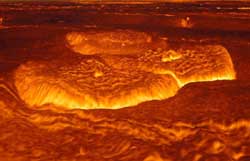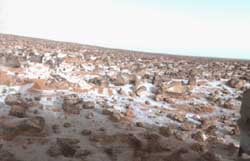

Left: Magellan radar image of Venus. Right: Martian snow at the Viking 2 lander site.
Not Too Hot, Not Too Cold, But Just Right!
An activity by Padi Boyd and Libby Truelove
related to the song:
'Habitable Zone'


related to the song:
'Habitable Zone'
Standards: physical science (matter exists in one of several states---solid, liquid or gas, depending on the temperature), measurement, following directions.
Adaptation: for younger children, the teacher will need to produce the fondue, as it requires working with a heat source. The Ziploc ice cream, on the other hand, can be made by students of all ages.
Engagement: Listen to the AstroCappella song Habitable Zone by the Chromatics. What does the song mean? Could people live on Venus and Mars right now? Why or why not? Have the students make suggestions for a list of differences between the Earth, and Venus and Mars. Did they remember that the oceans boiled off Venus because it is so close to the Sun? What about Mars having ice caps, but dry river beds? Did they remember it's a freezing place now? Now think about the Earth. What do we find all over the place on Earth? The surface of the Earth is covered mostly by water. What do we know about the distances of Venus, Earth and Mars from the Sun?
Today's activity is a tasty way of thinking about how lead, which is a solid metal on Earth, could melt and become metal on Venus. We'll also discover why we have liquid water oceans on Earth, while on Mars all the water is frozen in the ice caps. We'll be able to appreciate our very special place on Earth right in the Sun's habitable zone, where water can exist as a liquid. (And we'll get to appreciate some other special features that are only found on Earth, namely chocolate and ice cream!)
Engagement: Let the students each have a couple of chocolate chips. Are they liquid, solid or gas? What happens if they hold them in their hands a little too long? Why do they melt? The heat from their bodies is turning the solid into a liquid. What do you think would happen to the chocolate as we approached the surface of Venus?
Activity: In medium sauce pan or fondue pot, on stovetop on LOW heat, put about half of the cream and butter. Gradually add chocolate chips so that cream/butter combination evenly coats them. Make sure the entire combination heats very slowly so the chocolate does not burn. As the butter and chocolate melt smoothly and combine with the cream, continue to add the remaining cream, butter and chocolate chips gradually until the mixture reaches a consistency that will adhere easily to your dipping pieces. Let the students observe that the addition of heat to the chocolate has turned the solid chips, butter and the liquid cream into a thick liquid, similar to the consistency lead would achieve on the surface of Venus.
Remind the students that chocolate fondue does not actually cover the surface of Venus. This is just an analogy.
The teacher can now dip several items in the chocolate fondue and give each student a paper plate, fork and napkin. The dipped items should be allowed to cool down for a few minutes before handing off to young students. If making the ice cream in the same day, set aside remaining fondue as a topping for completed ice cream.
Engagement: What happens on a hot day when you're eating a nice, refreshing cold ice cream cone? Which planet would be a great place to eat ice cream if you didn't want it to melt so quickly? Does anyone know how ice cream is made?
Activity: Mix together in a large container the milk and cream. Give each student or team 1/2 cup of this mixture in a small Ziploc bag. To each bag, add 1/3 tablespoon of sugar, 1 teaspoon of vanilla. Students may add a handful of chocolate chips. Tightly seal the small bag.
In larger bag put about 20 ice cubes and 2 tablespoons of salt. Place the smaller bag within the larger bag filled with ice and salt. Double check the seal on the small bag so that no salty ice gets in the ice cream. Seal the large bag tightly. At their desks, students can turn the large bag over every few moments. In about 30 minutes the consistency of the material in the small Ziploc bag should start to resemble ice cream.
Let the students taste their creation with a plastic spoon and plenty of napkins.
Follow-up Activities: Send the ice cream recipe home with the students. Have them try modifying it to make "slushies" from ice cream.